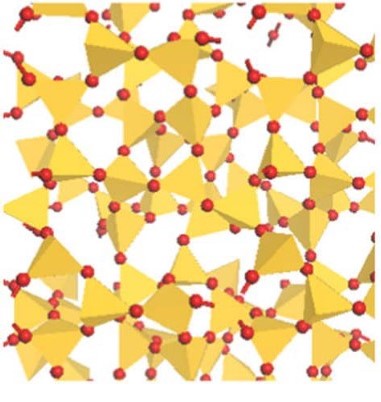GLASSES AND OUT-OF-EQUILIBRIUM SYSTEMS
Permanent Members: B. Champagnon (Pr), T. Deschamps (MCF), C. Martinet (IR), V. Martinez (MCF), B. Ruta (CR)
A glass is a non-equilibrium solid obtained after rapid cooling of a liquid in order to avoid crystallization. The structural organization of a glass depends on its thermal history and its mechanical history.
One of the specific features of the SOPRANO team is the expertise of multi-scale glass structure (from 100 nm atomic bond) through vibrational spectroscopy (Raman scattering, Brillouin scattering) and By X-ray absorption, X-ray scattering at small angles (Synchrotron ESRF). Numerical simulations using molecular dynamics are carried out in collaboration with the laboratory's MMCI team. Multiscale studies to determine the structural evolutions and elastic properties of glasses are carried out in situ or ex-situ under high mechanical stresses (very high pressures, micro-indentation, uniaxial compression) or in temperature. These fundamental studies have a long-term interest in the fields of building, glazing, smartphones, ...


Structure of SiO2 glass Raman spectra of SiO glass
MULTI-SCALE ANALYSIS OF THE PLASTIC DEFORMATION
Glass is a fragile material on a macroscopic scale but has some plasticity on a microscopic scale. A better understanding of this plasticity is essential to improve the mechanical strength of the glasses. Nevertheless, it is difficult to characterize this local plastic deformation at the experimental level because of its size and the theoretical level because of the amorphous nature of the glasses. Reinforcing the mechanical properties of glasses is a major challenge with significant economic benefits in the glass industry. To this end, for several years, the SOPRANO team has been engaged in research in collaboration with several laboratories in France and with St Gobain-research in a multidisciplinary physical-mechanical-chemical approach. Indeed, multiscale studies are carried out, one of the objectives of which is to improve our understanding of the possible links between the structure and the mechanical strength of the glasses. These studies are carried out by Raman spectroscopy on samples densified by high pressure, by micro-indentation, by compression of micro-pillars.
(a) (b)
(b)
(a) Photo of the silica-soda-calcium glass indent of charge 2 kg and associated (O, x, y) mark. The axes (O, x) and (O, y) correspond to the diagonals of the indent. (b) Representation of the lines of iso-density levels of the indented zones by the loads 1 kg and 2 kg.
GLASSES UNDER EXTREME CONDITIONS OF PRESSURE
Basic studies on the structural reorganisations at several scales of the glasses occurring under extreme conditions of pressure are carried out in order to improve our knowledge of the structure of the glasses.
Some highlights :
-
Anomaly of the module of incompressibility: links structure-elastic properties:
During the compression in the elastic domain, SiO2 glass and some alumino-sodo-silicate glasses exhibit a minimum of the modulus of incompressibility around 2 GPa. We have shown the links between this minimum and the structural reorganizations occurring during the compression.

(a) Brillouin displacement as a function of pressure, (b) Si-O-Si mean value of intertetrahedral angle (obtained as a result of Raman measurements) as a function of pressure
-
Structure of glasses according to their thermal and mechanical history:
In the plastic field, along the densification path (pressure, temperature), the structural organization of the glass differs for equivalent densities. The temperature during compression is directly correlated with the structural reorganization and the thermodynamic stability of the glass. In situ pressure and temperature studies of oxide glasses are carried out in order to decorrelate the role of temperature and pressure during structural reorganization.
(a)  (b)
(b)
(a) Raman spectra of two SiO2 glasses of the same density and different densification path (P, T), (b) Raman spectra of GeO2 glass under pressure and temperature
-
Study on the possible existence of polyamorphism in glasses, by analogy with polymorphism in crystals
Polyamorphism was demonstrated for the first time on ice and amorphous YAG. The team is studying this possible transition on oxide glasses (silicates, germanates) during compression. We have demonstrated a polyamorphic transition from a low-density amorphous molecular structure to a high-density lattice structure in a molecular lens of arsenic sulfide under high pressure.
Collaborations: Université de Davis (USA), University College London (UK), Aberystwyth University (UK)

Raman spectra of a molecular glass As3S4 at different pressures at ambient temperature

















